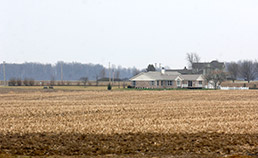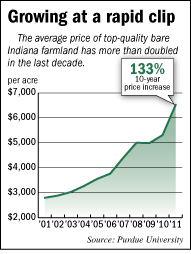Subscriber Benefit
As a subscriber you can listen to articles at work, in the car, or while you work out. Subscribe Now Ken Rulon, whose 5,000-acre farm is mostly in Hamilton County, thinks farmland is overvalued. But he remains bullish on farmland as a long-term investment. (IBJ Photo/ Perry Reichanadter)
Ken Rulon, whose 5,000-acre farm is mostly in Hamilton County, thinks farmland is overvalued. But he remains bullish on farmland as a long-term investment. (IBJ Photo/ Perry Reichanadter)For decades, Hamilton County development has marched relentlessly north, turning farmland into housing developments and strip centers. Until now.
A once-in-a-generation combination of strong grain prices, high farm incomes and unprecedented interest in commodities investments has caused prices for agricultural acreage to skyrocket. Purdue University’s 2011 farmland value survey found an acre of top-quality Hoosier farmland would set you back $6,521—an increase of 25 percent over the previous year.
Those prices are great news to sodbusters statewide, but they resonate particularly strongly in Hamilton County, where farming is still a big industry. Even though Hamilton County’s population of 275,000 includes perhaps only 350 to 400 full-time farmers, the county is still more than 40 percent farmland. The price of that land is so high—and demand from recession-hammered housing and retail developers so weak—that, for the first time in years, farmers are pretty much the only game in town for land sales.
“The other day, I spoke with my nephew, who farms, about it,” said Bill Rice, extension educator for the Hamilton County office of Purdue University’s Cooperative Extension Service. “He wonders when the bubble’s going to burst, and I don’t know that it will.”
Rice said that prime Hamilton County farmland—if you can find any on the market—can go for an astronomical $8,000 to $10,000 an acre. Those high prices have, for the moment, turned the tables on the area’s usual development pattern, in which developers outbid farmers for large tracts, then turn them into shopping centers or housing developments.
 Farmland prices took off about five years ago, around the time the recession pushed commercial development off a cliff, said John Snell of Snell Real Estate Evaluation Co., a local appraising and consulting firm.
Farmland prices took off about five years ago, around the time the recession pushed commercial development off a cliff, said John Snell of Snell Real Estate Evaluation Co., a local appraising and consulting firm.
Added Craig L. Dobbins, professor of agricultural economics at Purdue University: “In the environment we’re currently in, farmers are in a better position to compete with real estate developers than they were when there was a lot of growth going on.”
Investors seeking farmland’s safe, relatively steady returns have helped push prices higher. One of the biggest Indiana players is Ceres Partners LLC, a private equity firm based near South Bend that oversees more than 60 farms in Illinois, Michigan, Tennessee and Indiana.
It was co-founded by securities lawyer and trader Perry Vieth, whose only firsthand experience with farm life was bailing hay on a neighbor’s spread for a couple of summers in the early 1970s. But in 2008, he quit his job overseeing some $7 billion in assets at Boston-based PanAgora Asset Management and plowed his funds, literally, into farming.
“I wanted to invest my own personal assets into hard assets,” Vieth said.
They don’t come much harder than actual dirt. Vieth’s done most of his shopping in Indiana because prices in this state, though undeniably high, still don’t approach those in Iowa and Illinois.
“Iowa has great soils, so you have that reputation,” he said. “And I think you’ve got some wealthy farmers who compete for the ground. There have been some expensive sales in Indiana as well, but clearly it doesn’t get the attention that Iowa and Illinois get.”
Vieth thinks farmland is inflation-resistant, and that crops he raises will find ready and ever-expanding markets overseas. He said the growing Asian middle class wants meat and plenty of it, and you can’t get that without feeding cows and pigs grain. Lots and lots of U.S.-grown grain.
“It takes roughly seven pounds of grain to make one pound of beef, or about four pounds of grain to make a pound of pork,” Vieth said. “And the Chinese are the largest pork consumers in the world. You’re going to see more demand for grain to meet those needs.”
Yet almost no one believes prices can keep rising forever—or even much into 2013. Purdue’s Dobbins thinks they’re near the top of the bell curve right now.
“That doesn’t mean it will go down, but I certainly expect the rate of growth to slow,” he said.
Scarce supply
Interestingly, high prices haven’t triggered a rush to sell farmland and cash in. Indeed, there’s very little available for purchase.
That’s because many farmers take “buy and hold” to an entirely new level.
“Their notion is not to get rid of it,” Dobbins said. “When they buy it, they’re buying it as a part of their business, and many farmers pass the business on to the next generation. So when farmers buy land, it can be locked up for a long, long time.”
Few farmers embrace that mind-set with greater conviction than Ken Rulon, a partner in Rulon Enterprises, a family farm with 5,000 acres, most of them in northern Hamilton County.
The first members of Rulon’s family homesteaded the area in 1869, which gives him a unique perspective on the run-up in land prices. He—or rather, he and his ancestors—have seen it all before. Five times, in fact.
“This is the fifth cycle our family’s been through,” Rulon said. “In each one, you go through a process where the cost of farmland is insignificant to someone who wants to develop it. The other end of that cycle, where farmers can bid and be competitive with developers, is happening right now. So it swings back and forth.”
Rulon thinks the pendulum will start to swing in the opposite direction in the next year or so. Farmland, he thinks, is overvalued by perhaps nearly one-third and due for a correction. But not the sort that triggers financial bloodbaths and farm foreclosures.
“Because of the way this land advance has occurred, very few people are overextended,” he said. “I don’t think it’s fair to call it a bubble. Values are 30 percent above the normal growth curve, and it will come back to that curve.”
He said farmland in Clinton County recently changed hands for $8,700 an acre. Even if the ground loses 30 percent of its value, it still would be worth $6,000 an acre, Rulon noted. And he’s confident that 20 years from now, it will be worth a lot more than that.
“There’s just no leverage or speculation going on,” he said. “People are paying cash, because the cash flows [from farming right now] are so bizarrely high.”
Driving prices higher
Rulon said the run-up was triggered partly by nervous investors flocking to commodities—the same phenomenon that has caused gold prices to spike. Farm profits also are robust, thanks to strong demand for soybeans and corn, some of it used in ethanol production.
But Rulon doesn’t believe that growing Asian consumer markets are a bottomless maw that will keep commodity and land prices high. He thinks—as has happened during every other food shortage in living memory—that new yield-boosting production methods, along with an increase in land used for farming, will make up the difference.
Even so, Rulon said farmers aren’t prone to the sort of panic that caused the dot-com bubble to burst. He believes most are in it for the long haul, because they’ve seen that strategy pay off over decades.
Rulon likens owning agricultural real estate to owning a stock, since it both appreciates and pays a dividend (in the form of crop production or rental fees).
“That dividend, with the exception of four or five years during the last 90, has increased on an annual basis by 3 percent,” he said. “Add that to the fact that land holds its value and becomes more productive over time, and it’s pretty normal to get 8 to 9 percent annual returns.”
He also counts his blessings that he farms in central Indiana, right on the edge of Indianapolis’ slowed but continuing outward sprawl. Unlike central Illinois or Iowa, where agriculture is the only game in town, commercial suitors in his neck of the woods help keep prices firm.
“We’re really blessed in central Indiana,” Rulon said. “There’s more than one use for the real estate. If values got really cheap around here, some people with names like Simon would just start buying it up to hold it. The wave of money splashing north from Indianapolis is going to keep coming, probably forever.”•
Please enable JavaScript to view this content.
